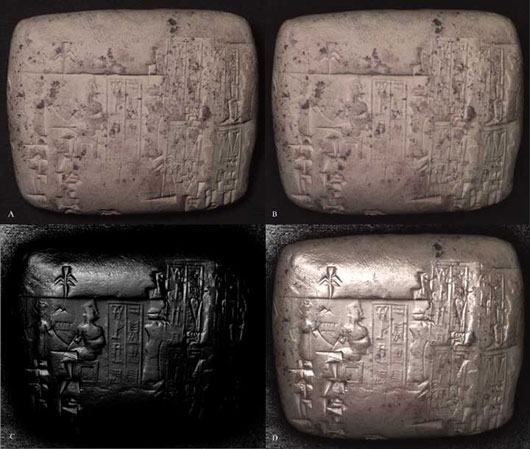
Last week I wrote about how Mogi Vicentini's animation of the workings of the Antikythera mechanism drew spontaneous applause from the audience when I showed it during my recent talk at the Royal Institution. (By the way, a few people have said they're having trouble getting the file on Mogi's site to run - I got it to work by downloading a free VLC media player, or you can look at the version hosted by the Guardian in their blog post on my talk - lower res but still beautiful.)
Something else I showed in the talk that drew a satisfying gasp from the audience was a demonstration of the lighting technique, developed by Hewlett Packard's Tom Malzbender, that was used to illuminate the engraved lettering on the Antikythera mechanism. A metre-wide plastic dome, covered with flashbulbs, is used to take photos of an object lit from 50 different directions. The images are fed into a computer and used to make a reconstruction of how the surface of the object reflects light. Once that's done, you can ask the computer to light the object from any angle, even impossible ones like beneath its surface, or you can change how the surface reflects light - such as making the crumbling stone of a cuneiform tablet as shiny as metal (see pic). Then it's just a case of playing around to find the effect that makes the lettering as clear as possible.
You can try this for yourself on Hewlett Packard's website. Click on one of the images (my favourite is the tablet on the top left) to download the interactive demo in a new window, then move the mouse around to change the direction of the light. Or (this is the bit where everyone gasped) right click on the image to bring up a little menu, and under "effects" turn on "specular".
You can also try this with images of the Antikythera mechanism. The bottom right image, AK01a-512, is a good one to try, as it shows a piece of bronze plate from the device, that's covered in inscriptions.
News is also out in New Scientist today that Malzbender has adapted this lighting technique for use with an ordinary flatbed scanner. You can't get quite the same effects of course but the method could be useful for smoothing out creases or tears in images of old photos or documents.
Flatbed scanners use two separate lightbulbs so taking one scan gives you information from two different lighting directions. Rotating the photo or document by 90 degrees and scanning again increases that to four - more than enough for Malzbender's software to glean 3D information about the surface that's being scanned. The software highlights any pixels that aren't lying flat against the scanner (suggesting a rip or fold) and replaces them with nearby ones. Cunning.